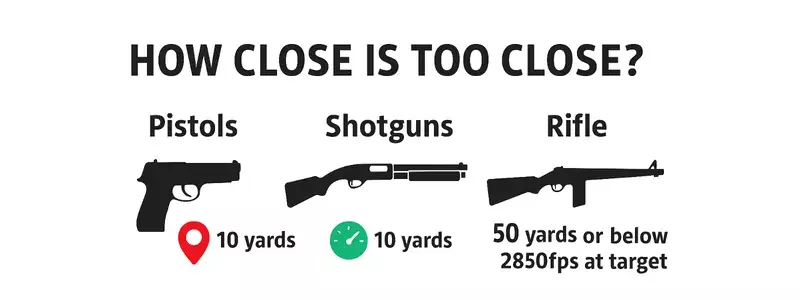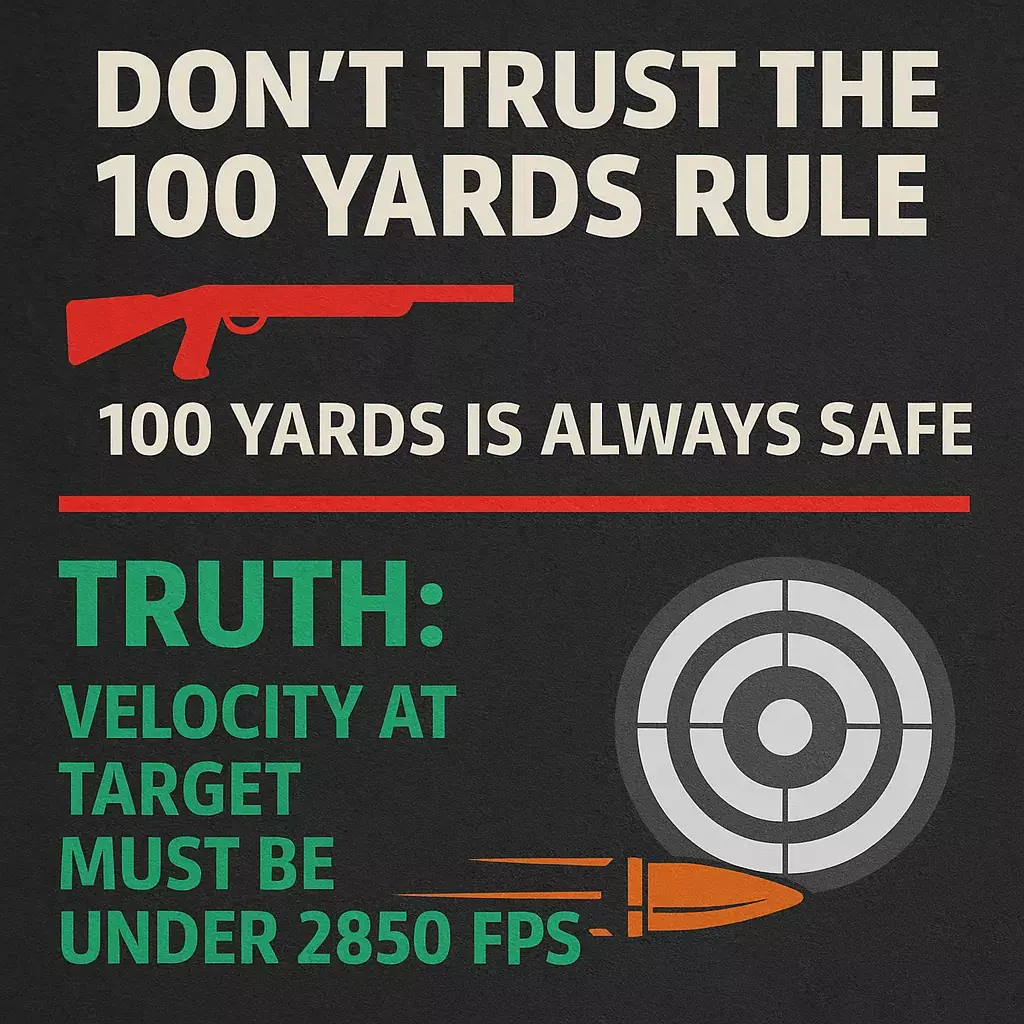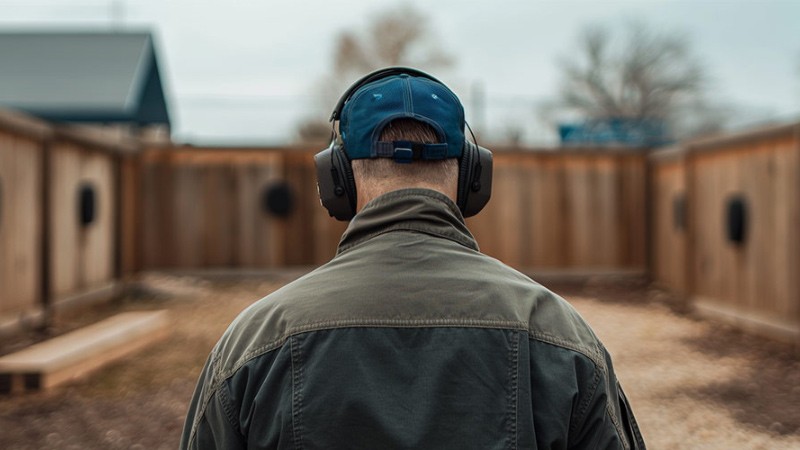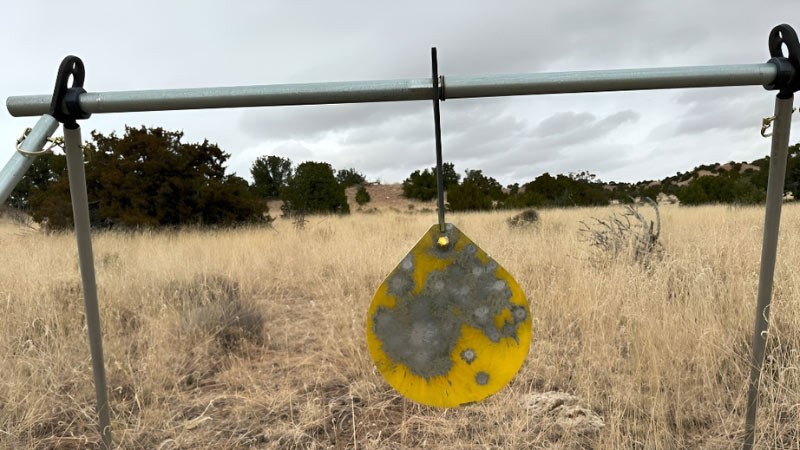How Close Can You Shoot Steel Targets? Tips for Shooting Steel Safely

How close you can shoot steel targets depends on the firearm being used.
Minimum safe distances: Pistols/shotguns - 10 yards; Rifles - 50 yards or adjust for speed below 2850fps at target.
These are general rules, read on for more info.

Understanding the Safe Distance When Shooting Steel Targets
If it's your first time, or if you're an experienced shooter, it's vital to heed these guidelines for shooting steel targets safely. If you're setting up your range, consider using quality steel targets like those from Shooting Targets 7, designed to enhance your shooting experience while prioritizing safety.
When it comes to shooting steel targets, ensuring your safety and that of those around you is paramount. It's crucial to know how closely can you shoot steel targets to prevent ricochets and splatter. The safe distance primarily depends on the type of firearm and the caliber being used. Generally, for pistols, you can shoot at steel targets from a minimum of 10 yards away. As for rifles, that safe distance increases significantly especially if your velocity is over 2850fps.
BEWARE OF BAD INFO;
There is a common misconception that it is OK to shoot all rifles as long as you're 100 yds away, this is WRONG.
Why would the distance from the target matter when nearly every centerfire rifle produces different velocities depending on barrel length, ammo selection, and many other factors?
The simple answer: it doesn't. The only thing that truly matters is the bullet's speed at impact with the steel.
To avoid pitting your targets always keep your bullet speed BELOW 2850fps at the targets. If you're faster than that at 100 yds you need to back up until you're not. This pitting happens from the heat being put into the targets at higher speeds.
Keep in mind that Angle matters when deciding how to mount steel targets. They should be angled downward to direct splatter towards the ground. And remember, if you hear a pinging sound, it's a good indication that your distance is on point and the target is effectively absorbing the energy of the shot.
However, if you notice any pitting or dents in your steel targets, it's time for maintenance or replacement, ensuring the longevity of your gear and continued safety on the range. As always, wear appropriate personal protective equipment, and never forget that safety comes first when you're having fun at the range.

How to Determine a Safe Distance for Steel Target Practice
Determining a safe distance for steel target practice is crucial to ensure a secure shooting environment. When you're shooting steel targets, the primary concern is the ricochet hazard.
Bullets containing steel can bounce back if you're too close, which can pose a serious threat. So, how closely can you shoot steel targets? It often depends on the caliber and type of the firearm you're using. You should also understand how thick your targets should be to avoid damaging them.
Generally, for smaller calibers like .22LR, you can be as close as 10 yards. However, for high-velocity rounds, you'd want to maintain a distance of at least 50 yards. If you're shooting rifles, the minimum safe distance typically increases due to the higher velocity and energy of the projectiles.
To shoot steel safely, always ensure your target is made of high-quality AR500 steel, like those provided by Shooting Targets 7. Targets of lesser quality can create unpredictable splatter patterns. Moreover, the angle of the steel target is also pivotal.
A target angled downward will direct the bullet fragments to the ground. If you're a shooter who likes to push boundaries, remember, your safety and the safety of observers is the priority.
Always refer to the manufacturer's recommendations and local range rules. When you adhere to these guidelines and use common sense, you can enjoy the satisfying ring of bullet on steel without compromising safety.

Why You Should Choose High-Quality Steel Targets for Safety
When engaging in target practice, whether you're a seasoned shooter or a novice, choosing high-quality steel targets is paramount for your safety. Opting for premium steel targets isn't just a matter of performance, but it's crucial for ensuring that every round you fire towards your target doesn't pose a risk to you or others.
The robustness of high-quality steel targets means they can withstand repeated shooting, which is essential because when you shoot steel targets that are subpar, they can become compromised and lead to dangerous ricochets or fragmentations.
Moreover, investing in the finest steel targets reinforces safety protocols because they can endure the force from various calibers without deterioration.
When you shoot steel, it's imperative that the target can reliably handle the impact. Inferior targets might be tempting due to their lower cost, but they can quickly become riddled with craters and unsafe to use.
To maximize safety when shooting steel targets, it’s vital to ensure they are made from the correct hardness and quality of steel, typically AR500 or AR550, to effectively dissipate energy and minimize hazardous back splatter.
Equally important is knowing how close you should stand when you're ready to shoot steel targets. Adherence to recommended safe distances reduces risk, as does choosing a reputable source for your shooting steel targets, such as Shooting Targets 7.
Remember, quality and safety go hand-in-hand; so, don't compromise – investing in top-tier steel targets is a choice you should definitely make for a safe and enjoyable shooting experience.

How Close Can You Safely Shoot Steel Targets?
Understanding how closely you can shoot steel targets without compromising safety is critical for any responsible shooter. While steel targets provide excellent feedback and durability, knowing the minimum safe distance is crucial to avoid ricochet or splatter injuries.
When you're out on the range, it's essential to recognize that the distance from which you can safely shoot steel targets varies based on factors such as bullet caliber, target construction, and angle of deflection.
Generally, for handguns, a distance of 10 yards is considered safe for shooting steel. However, when it comes to rifles, you should increase that distance substantially to minimize risk. Always make sure the steel targets are angled down slightly to direct any bullet fragments towards the ground.
High-quality steel targets, like those offered by Shooting Targets 7, are manufactured to withstand repeated rounds without significant surface damage, further ensuring your shooting practice remains as safe as possible.
Moreover, when you're considering how close you can get to your target, remember the type of ammo you're using. Steel-core or armor-piercing rounds can create a higher risk when shot at close range. It's not just about how close you can shoot, but also how you shoot steel that determines your safety.
Always inspect your steel targets before and after use to ensure they haven't been compromised. In summary, always prioritize safety above all else, and remember that no shot is worth taking if it means putting yourself or others at risk.
Keep these tips in mind, and you can enjoy the durability and immediate feedback that steel targets offer, ensuring a *safe* and *enjoyable* shooting experience every time.

Mitigating Spatter: Strategies for Shooting Steel Targets Closer
When you're eager to shoot steel with greater precision, mitigating spatter becomes crucial in your list of strategies. Spatter, the fragments that ricochet off your target, can pose a risk at close range, but there are ways to reduce this hazard and shoot steel targets closer with confidence.
Firstly, ensure that you're shooting at a steel target designed for the caliber you're using; not all steel targets are created equal, and high-quality steel significantly diminishes the risk of spattering.
Moreover, the angle at which you shoot steel directly influences the direction of bullet fragmentation. Shooting at a downward angle can steer spatter towards the ground, keeping it away from you and your fellow shooters.
While you can employ several strategies for closer steel shooting, one of the core tactics is to increase the incline of the target. By tilting the steel target slightly forward, the spatter is directed downward, mitigating the risk of ricochet. Remember though, even with mitigating tactics, maintaining a safe distance is a non-negotiable aspect of shooting steel.
As you aim to shoot steel targets that are closer, always prioritize safety protocols, and if in doubt, extend the distance. Finally, don't forget to attire yourself with appropriate safety gear, especially eye protection, to guard against any rogue spatter.
With these strategies, you can safely enjoy the rewarding ping of steel targets with Shooting Targets 7, ensuring that every shooting session at Quantico Club is both thrilling and secure.

What Is AR500 Steel and Its Importance in Shooting Targets?
When it comes to shooting steel, understanding the significance of the target material is key to both safety and durability. AR500 steel targets are central in the shooting sports realm, known for their robustness and ability to withstand repeated hits.
So, what is AR500 steel? It's a grade of abrasion-resistant (AR) steel that can handle the high-velocity impact of bullets without suffering deep pitting or craters. This characteristic is crucial if you're engaging in shooting steel regularly because it ensures the longevity of your targets.
The importance of using AR500 steel targets can't be overstated; they offer consistent performance and are less prone to damage than their softer steel counterparts. The resilience of this steel means you can shoot steel targets time and time again without significant wear and tear.
High-quality steel targets made from AR500 steel reflect the dedication to safety and quality, given their superior resistance to deformation and fragmentation. When you're on the range, knowing you can shoot steel — specifically AR500 steel targets — provides a peace of mind that's invaluable.
While considering the importance of shooting steel responsibly, it's essential to ask yourself—can I maintain this target's integrity over time? If high-quality AR500 steel is your choice, the answer will likely be affirmative.
The use of AR500 steel in your steel targets ensures that you and fellow shooters can enjoy the shooting experience with reduced risk of ricochet or spatter, especially if adhering to recommended safe distances.

General Guidelines for Shooting Steel Targets at a Closer Range
When it comes to shooting steel targets, understanding the general guidelines for a closer range is vital to your safety and enjoyment of the sport. Steel targets provide immediate feedback with a satisfying 'ping' when hit, and can be an excellent tool for shooters aiming to enhance their skills.
However, it’s crucial to know just how close you can shoot steel to maintain safety. To adequately gauge your distance, consider that high-quality, durable materials like AR500 steel targets are imperative. They're designed to withstand repeated shots without significant damage.
First and foremost, let's talk about target distance. When you're setting up steel targets for shooting at a closer range, a minimum standoff distance is essential to reduce the risk of ricochet or spatter coming back at you.
There's a reason seasoned shooters say, 'Distance is your friend' — it gives you time to react in case something goes awry. When you shoot at closer range, particularly under 10 yards for handguns and 100 yards for rifles, the angle of the steel, target quality, and ammunition type can drastically affect your safety.
Choosing shooting targets like the Shooting Targets 7 offerings, made from reliable AR500 steel, is a smart way to mitigate risks.
Remember, whether you're a novice or an experienced marksman, always prioritize safety and follow the established guidelines; those set by the shooting community or specific ranges are there for your protection.
Acknowledging and respecting these rules is non-negotiable – it's how we ensure everyone can enjoy the sport and shoot steel targets responsibly. So, next time you're at the range, step back, take aim, and shoot with confidence, knowing you're within the bounds of safety.
